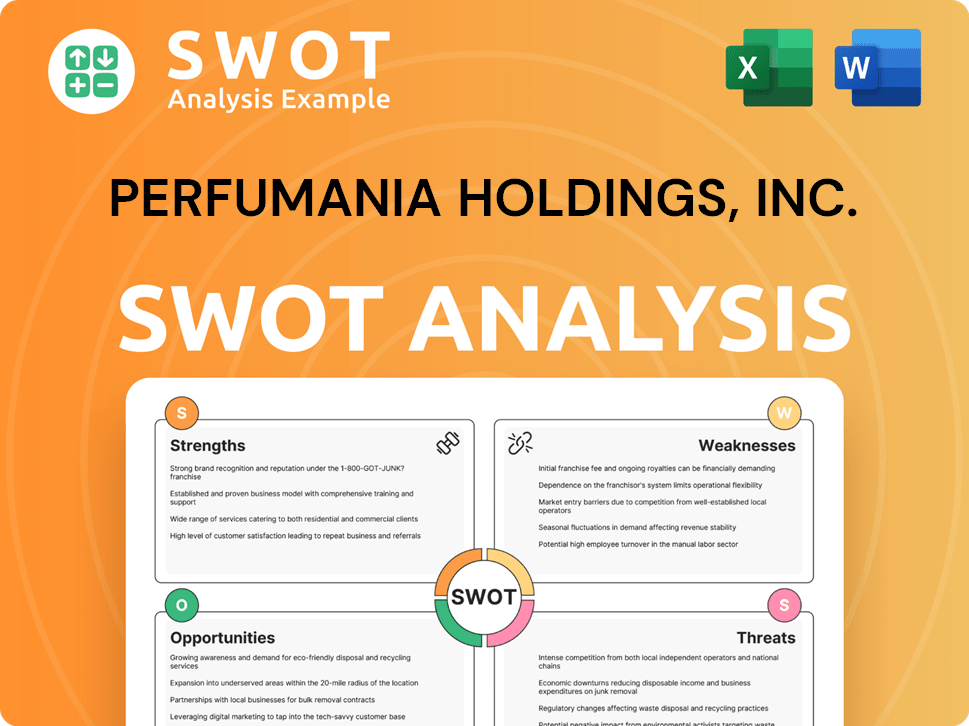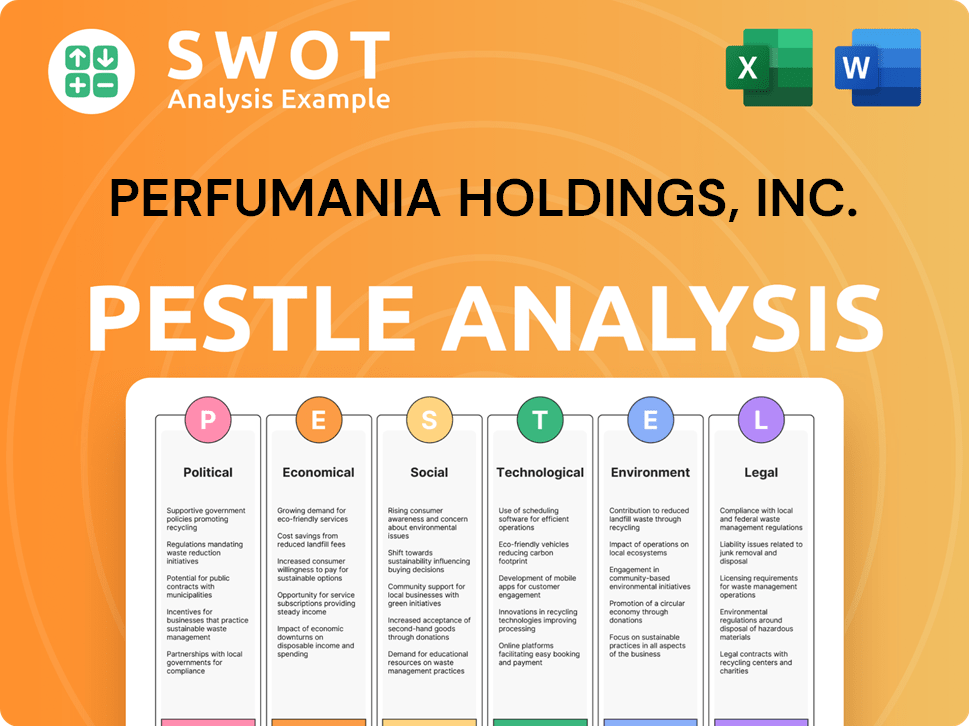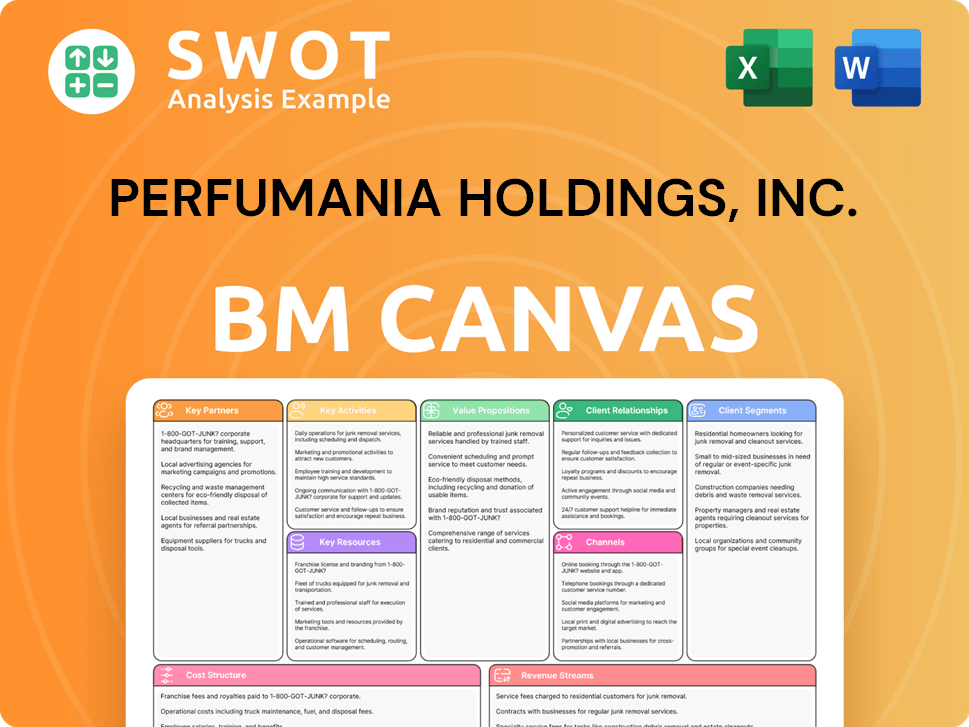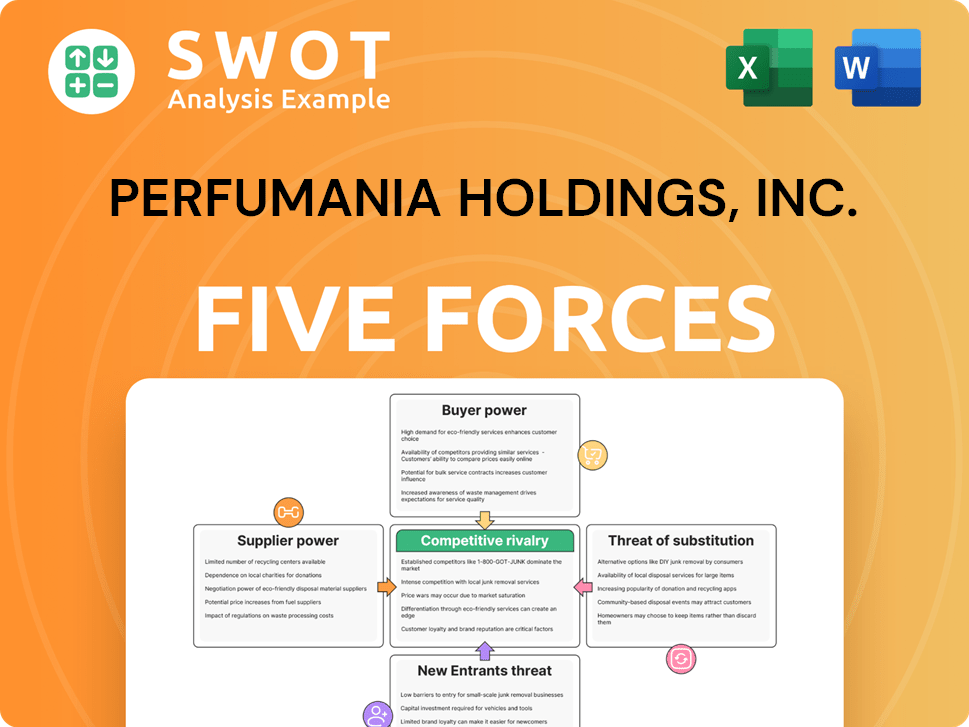Perfumania Holdings, Inc. Bundle
How Does Perfumania Holdings Thrive in the Fragrance Market?
Perfumania Holdings, Inc. is a major player in the U.S. fragrance industry, operating as both a wholesale distributor and a specialty retailer. They offer a wide variety of perfumes and fragrances through their Perfumania stores and online platform. Understanding Perfumania's business model is key to grasping its market position and potential for growth.

With the global fragrance market projected to reach $52.4 billion by 2025, Perfumania Holdings, Inc. SWOT Analysis provides crucial insights. This article delves into Perfumania's operations, from its wholesale distribution to its retail strategy, examining how it adapts to evolving consumer preferences and the competitive landscape. Learn about the company's approach to e-commerce, store optimization, and its strategy for sustaining profitability as a leading perfume retailer.
What Are the Key Operations Driving Perfumania Holdings, Inc.’s Success?
The core operations of Perfumania Holdings, Inc. are built on a vertically integrated model that combines wholesale distribution and specialty retail sales. This structure allows the company to serve a wide array of customers, from large retailers to individual consumers. The company's business model focuses on providing designer fragrances and related products through multiple channels, ensuring broad market reach and customer accessibility.
The company's value proposition centers on offering popular fragrance brands at competitive prices. This strategy is supported by an omni-channel approach that integrates online and physical stores. This integration enhances the customer experience and drives sales, as seen by the reported increase in online sales in 2024 due to these initiatives.
Perfumania's wholesale segment, operating through subsidiaries like Quality King Fragrance, Inc. (QFG), distributes fragrances to various outlets, including mass market retailers and drug stores. Parlux Fragrances, LLC, and Five Star Fragrance Company, Inc. manufacture and license fragrance brands. The wholesale business benefits from established relationships and an efficient sourcing strategy.
The retail business is primarily conducted through Perfumania, Inc., which operates a chain of retail stores and an e-commerce platform, Perfumania.com. These stores specialize in selling fragrances at discounted prices, often up to 75% below suggested retail prices. The e-commerce platform offers a broader selection of products.
The company's value proposition is centered on offering popular fragrance brands at competitive, discounted prices, attracting budget-conscious consumers. An omni-channel strategy integrates online and physical stores to enhance customer experience and sales. The company's strategy is supported by an efficient supply chain and a focus on customer satisfaction.
Perfumania holds a significant position in the fragrance industry. The company's ability to offer a wide range of products at competitive prices has helped it maintain a strong market presence. For additional insights into the ownership structure and key stakeholders, explore Owners & Shareholders of Perfumania Holdings, Inc..
Perfumania's core operations include wholesale distribution and specialty retail, which are supported by an omni-channel strategy. The company's focus on discounted pricing and a wide product selection helps attract a broad customer base.
- Wholesale distribution through subsidiaries like QFG.
- Retail operations via Perfumania stores and Perfumania.com.
- Competitive pricing, often up to 75% off.
- Omni-channel strategy driving online sales growth.
Perfumania Holdings, Inc. SWOT Analysis
- Complete SWOT Breakdown
- Fully Customizable
- Editable in Excel & Word
- Professional Formatting
- Investor-Ready Format

How Does Perfumania Holdings, Inc. Make Money?
The revenue streams and monetization strategies of Perfumania Holdings, Inc. revolve around the sale of fragrances and related products. The company operates through two primary segments: wholesale distribution and specialty retail, offering a diverse range of designer perfumes and brands.
While specific recent financial data for 2024-2025 is limited, historical data indicates a balanced revenue mix. This overview provides insights into how Perfumania, a key player in the fragrance industry, generates its income and maintains its market position.
Perfumania's business model emphasizes competitive pricing and a value proposition of offering well-known brands at lower prices. This approach, along with strategic marketing and efficient supply chain management, supports its revenue generation and profitability.
The wholesale division includes sales from Quality King Fragrance, Parlux, and Five Star Fragrance Company. QFG distributes fragrances to various retailers, including mass market, drug, and chain stores, as well as retail wholesale clubs.
Retail revenue comes from Perfumania's physical stores and its e-commerce platform, Perfumania.com. These channels offer a wide range of brand-name and designer fragrances, often at discounted prices.
In fiscal 2016, the retail division accounted for 50.6% of net sales, while the wholesale division contributed 49.4%. In fiscal 2015, retail provided 54.1% of net sales and wholesale 45.9%.
Parlux and Five Star generate revenue through the ownership and licensing of designer and other fragrance brands, earning royalties based on a percentage of sales.
The holiday season, particularly December, is a significant period for retail revenues, accounting for approximately 21.0% and 20.4% of retail revenues in fiscal 2016 and 2015, respectively.
The company aims to maximize sales and store productivity by increasing the average dollar sale per transaction and transactions per hour. Efficient supply chain management is a key strategy.
Perfumania, a leading perfume retailer, focuses on several key strategies to drive revenue and profitability. These include competitive pricing, strategic marketing, and efficient supply chain management, as highlighted in the Growth Strategy of Perfumania Holdings, Inc. article.
- Competitive Pricing: Offering designer fragrances at discounted prices to attract customers.
- In-Store Promotions: Utilizing promotions, signage, displays, and ad campaigns to merchandise and promote products.
- E-commerce Platform: Leveraging Perfumania.com to reach a wider customer base and drive online sales.
- Holiday Season Focus: Capitalizing on increased sales during the holiday season, particularly in December.
- Supply Chain Efficiency: Maintaining high profit margins through an efficient supply chain for core fragrance products.
Perfumania Holdings, Inc. PESTLE Analysis
- Covers All 6 PESTLE Categories
- No Research Needed – Save Hours of Work
- Built by Experts, Trusted by Consultants
- Instant Download, Ready to Use
- 100% Editable, Fully Customizable

Which Strategic Decisions Have Shaped Perfumania Holdings, Inc.’s Business Model?
The strategic journey of Perfumania Holdings, Inc. has been marked by significant shifts, particularly its 2017 recapitalization and transition to a privately-held entity. This move included filing for Chapter 11 relief, a strategic maneuver aimed at addressing financial challenges and adapting to evolving consumer behaviors. The company has focused on optimizing its retail footprint and increasing its e-commerce investments.
Operationally, Perfumania has navigated the challenges of a changing retail landscape, especially the shift from brick-and-mortar stores to online shopping. This has led to a focus on reducing overhead, improving supply chain efficiency, and optimizing marketing spend. The company has also concentrated on cost-cutting measures to stay competitive.
Perfumania's competitive advantages are rooted in its vertically integrated model, which includes both wholesale distribution and specialty retail. This structure provides a broad market reach and a diverse product offering. The company benefits from established relationships with manufacturers and large customers. Offering designer fragrances at discounted prices, often up to 75% below suggested retail, is a key strategy.
The 2017 recapitalization and shift to private ownership were critical. This involved filing for Chapter 11, a strategic move to restructure and adapt to market changes. The focus was on reducing the retail footprint and investing in e-commerce.
Perfumania has focused on reducing overhead and improving supply chain efficiency. It has also optimized marketing spending and reduced expenses. The company strategically expanded its market presence through new store openings and diversification into different locations.
The vertically integrated model, encompassing wholesale and retail, provides a broad market reach. Established relationships with manufacturers and the recognition of proprietary brands are also key. The company’s ability to offer designer fragrances at discounted prices is a significant advantage.
Ongoing review and improvement of product and sales strategies are essential. This includes acquiring new fragrance licenses and introducing new products. The company is also shifting towards designer and heritage fragrances.
Perfumania is continuously adapting to market trends and competitive pressures. This involves strategic acquisitions of new fragrance licenses and the introduction of new products to meet changing consumer preferences. The company is also focusing on designer and heritage fragrances.
- Focus on designer and heritage fragrances to improve margins.
- Emphasis on omni-channel strategy, integrating online and physical stores.
- Continuous review and improvement of product and sales strategies.
- Strategic expansion through new store openings in high-traffic areas.
Perfumania Holdings, Inc. Business Model Canvas
- Complete 9-Block Business Model Canvas
- Effortlessly Communicate Your Business Strategy
- Investor-Ready BMC Format
- 100% Editable and Customizable
- Clear and Structured Layout

How Is Perfumania Holdings, Inc. Positioning Itself for Continued Success?
The fragrance industry, where Perfumania Holdings, Inc. operates, is a competitive global market. The market was valued at around $50.7 billion in 2023 and is expected to reach $66.8 billion by 2029. This indicates a projected annual growth rate of 4-5% through 2025. Perfumania positions itself as a specialty retailer and wholesale distributor within this market, competing with various retail channels.
Key risks include the shift to e-commerce, which affects brick-and-mortar stores, and intense competition from major retailers. Regulatory changes and supply chain disruptions also pose challenges. The company's reliance on a few significant wholesale customers introduces vulnerability, potentially impacting investor confidence.
As a perfume retailer and wholesale distributor, Perfumania competes with department stores, online retailers, and other outlets. The company leverages its vertically integrated model and offers popular brands at discounted prices. While specific market share data is unavailable for 2024-2025, Perfumania's long-standing presence contributes to its market position.
The shift to e-commerce and declining mall traffic pose risks, necessitating store closures. Competition from major retailers like Sephora and Ulta Beauty impacts profit margins. Regulatory changes and potential product recalls add to the challenges. Supply chain disruptions, as experienced by 55% of respondents in a late 2024 survey, also present an ongoing risk.
Perfumania plans to grow its licensed and owned brands, enhance its e-commerce platform, and open new retail locations. The company aims to capitalize on the e-commerce boom, with U.S. online retail sales reaching $1.1 trillion in 2023. Expansion into eco-friendly fragrances and niche perfumes offers further opportunities.
The company is focusing on expanding its portfolio and improving returns from its retail store footprint. Adapting to consumer preferences, such as the growing interest in natural and sustainable ingredients, is a key strategy. The goal is to sustain and expand its ability to make money by adapting to evolving consumer preferences.
The fragrance market is seeing a rising preference for unique and personalized fragrances. Niche perfumes are growing at 10-15% annually in 2024. The focus on sustainable products provides avenues for expansion.
- E-commerce growth drives online sales, with continued expansion expected in 2024/2025.
- Growing consumer interest in natural and sustainable fragrance options.
- Increasing demand for personalized and niche perfumes.
- Strategic initiatives to leverage vertically integrated operations.
Perfumania Holdings, Inc. Porter's Five Forces Analysis
- Covers All 5 Competitive Forces in Detail
- Structured for Consultants, Students, and Founders
- 100% Editable in Microsoft Word & Excel
- Instant Digital Download – Use Immediately
- Compatible with Mac & PC – Fully Unlocked

Related Blogs
- What are Mission Vision & Core Values of Perfumania Holdings, Inc. Company?
- What is Competitive Landscape of Perfumania Holdings, Inc. Company?
- What is Growth Strategy and Future Prospects of Perfumania Holdings, Inc. Company?
- What is Sales and Marketing Strategy of Perfumania Holdings, Inc. Company?
- What is Brief History of Perfumania Holdings, Inc. Company?
- Who Owns Perfumania Holdings, Inc. Company?
- What is Customer Demographics and Target Market of Perfumania Holdings, Inc. Company?
Disclaimer
All information, articles, and product details provided on this website are for general informational and educational purposes only. We do not claim any ownership over, nor do we intend to infringe upon, any trademarks, copyrights, logos, brand names, or other intellectual property mentioned or depicted on this site. Such intellectual property remains the property of its respective owners, and any references here are made solely for identification or informational purposes, without implying any affiliation, endorsement, or partnership.
We make no representations or warranties, express or implied, regarding the accuracy, completeness, or suitability of any content or products presented. Nothing on this website should be construed as legal, tax, investment, financial, medical, or other professional advice. In addition, no part of this site—including articles or product references—constitutes a solicitation, recommendation, endorsement, advertisement, or offer to buy or sell any securities, franchises, or other financial instruments, particularly in jurisdictions where such activity would be unlawful.
All content is of a general nature and may not address the specific circumstances of any individual or entity. It is not a substitute for professional advice or services. Any actions you take based on the information provided here are strictly at your own risk. You accept full responsibility for any decisions or outcomes arising from your use of this website and agree to release us from any liability in connection with your use of, or reliance upon, the content or products found herein.